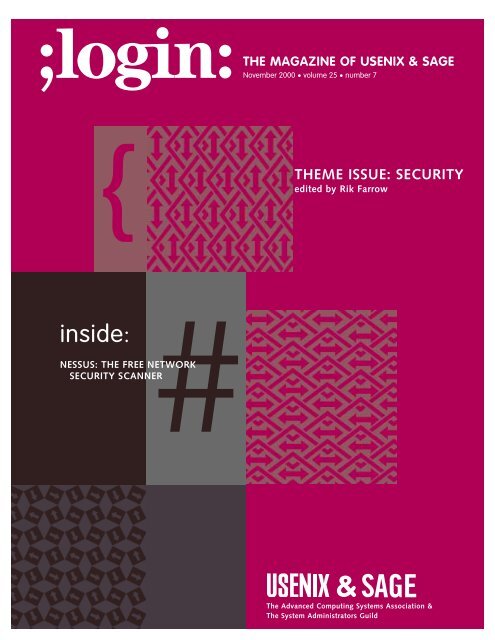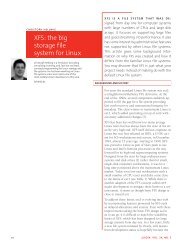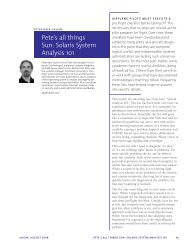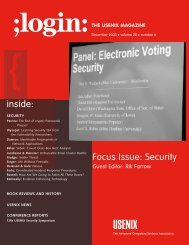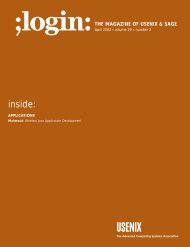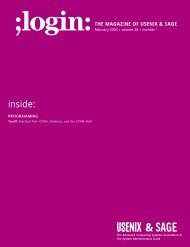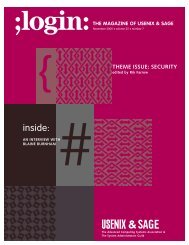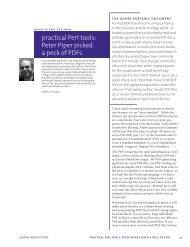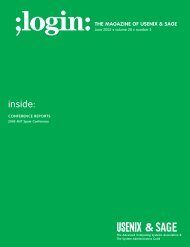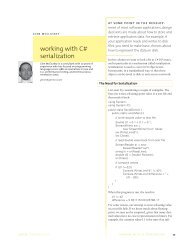Nessus
Nessus
Nessus
Create successful ePaper yourself
Turn your PDF publications into a flip-book with our unique Google optimized e-Paper software.
THE MAGAZINE OF USENIX & SAGE<br />
November 2000 • volume 25 • number 7<br />
{<br />
THEME ISSUE: SECURITY<br />
edited by Rik Farrow<br />
#<br />
NESSUS: THE FREE NETWORK<br />
SECURITY SCANNER<br />
inside:<br />
&<br />
The Advanced Computing Systems Association &<br />
The System Administrators Guild
nessus: the free<br />
network security<br />
scanner<br />
A network scanner is a tool for analyzing network services, available on a<br />
given set of systems. With <strong>Nessus</strong>, a new breed of scanners has been published<br />
capable of running real attacks, often called exploits, in order to<br />
determine that well-known system deficiencies can be exploited when running<br />
the attack against the scanned systems.<br />
History<br />
When <strong>Nessus</strong> was born back in 1998, it was just cool to have a free network scanning<br />
and attacking tool with design goals similar to SATAN, written by Wietse Venema and<br />
Dan Farmer. Right from the start, <strong>Nessus</strong> was set up as a client-server tool endowed<br />
with its own communication protocol. The scanning and attacking workload was put<br />
onto the server, and the presentation of the data was done by the client, very similar to<br />
the design of SATAN.<br />
In addition to that, the client realized better online control. So each host under scan<br />
and attack could be released from the scanning, individually, at any time. SATAN’s<br />
design launched the server and waited for the scanning to complete, without any control<br />
over the process. The attacks used by <strong>Nessus</strong> only test for vulnerabilities and do not<br />
actually perform a “break-in.”<br />
<strong>Nessus</strong> was planned and introduced to be publicly supported as a free software project.<br />
Seen from an organizational standpoint, this only meant that the source code of both<br />
the client-server platform and the plugin code database (the implementation of the<br />
attacks and the scans) are open for public use and discussion.<br />
Licensing Concept and Support Considerations<br />
<strong>Nessus</strong> has been released under the GNU Library General Public License (renamed to<br />
Lesser GPL in 1999), which might be further restricted, partly by some contributions to<br />
<strong>Nessus</strong>.<br />
Within one tool, a freely available set of working proof-of-concept attacks has been<br />
published. This is still unique, as the size of the <strong>Nessus</strong> database is far beyond that of<br />
any other scanner, even commercial collections.<br />
The authors of <strong>Nessus</strong> strongly believe in the free and open-source approach. This has<br />
a clear impact on the general acceptance of and contributions to <strong>Nessus</strong>. Many bugs<br />
and exploits are probably found by individuals, favoring a public and open audience<br />
rather than making a quick buck with a company that solely handles the exploits as<br />
classified information.<br />
The software can be deployed, tested, and modified freely. There is public bug-track<br />
management and a searchable mailing list. Additionally, professional software support<br />
is offered for commercial users to provide (legal) support contracts.<br />
Implementation Notes<br />
With the scanning and attacking database, <strong>Nessus</strong> aims to be as complete as possible. It<br />
currently performs over 500 security checks. This includes advanced Windows NT<br />
checks such as testing for permission to access the registry keys remotely, or for inappropriately<br />
shared partitions.<br />
by Renaud<br />
Deraison<br />
Renaud Deraison was<br />
tired of people<br />
complaining of the<br />
cost needed to bring<br />
their network to a<br />
decent level of<br />
security, so he started<br />
to write free tools to<br />
help them to achieve<br />
their goal at a much<br />
lower cost.<br />
<br />
and Jordan Hrycaj<br />
Jordan Hrycaj works<br />
as independent security<br />
consultant and<br />
joined the <strong>Nessus</strong><br />
project in late 1998.<br />
He believes that clever<br />
system solutions are<br />
always born in the<br />
mind rather than<br />
designed with the<br />
latest development<br />
tool.<br />
<br />
RENAUD DERAISON AND JORDAN HRYCAJ ARE<br />
THE AUTHORS OF NESSUS AND THE FOUNDERS<br />
OF THE NESSUS CONSULTING S.A.R.L.<br />
● SECURITY<br />
November 2000 ;login:<br />
NESSUS ●<br />
45
<strong>Nessus</strong> has been designed<br />
to be easily installed and<br />
handled by a user or an<br />
operator.<br />
While attacking, the intention is not to miss any vulnerabilities whatsoever. For<br />
instance, nobody prevents you from opening a Telnet service on port 32 rather than 23,<br />
and a testing tool should be able to find that out. <strong>Nessus</strong> will actually probe open ports<br />
with unusual port addresses to see if Telnet or something like it is running there. Being<br />
that flexible has not been common for a long time and probably is still uncommon,<br />
especially with commercial software.<br />
<strong>Nessus</strong> does not guess a host or operating-system type by reading the greeting message<br />
banner of the Telnet program. Long after QUESO and NMAP introduced the IP-stack<br />
fingerprinting approach, the banner method is still common practice with many other<br />
tools.<br />
A Strategic Tool<br />
As of today, <strong>Nessus</strong> has been used as a tool to enforce the security policy of a company<br />
site, institution, or organizational entity. <strong>Nessus</strong> goes much further than answering<br />
questions like “Does my firewall have the particular bug reported in the BugTraq list<br />
the other day”<br />
The <strong>Nessus</strong> project aims to provide a tool to check out and analyze the network as seen<br />
from a security standpoint that is<br />
■ comprehensive and reliable<br />
■ distributed<br />
■ continuously up-to-date<br />
■ well known<br />
■ cost effective<br />
In the strategic setting up and running it has some similarities with network probes<br />
commonly installed and used to monitor data and voice traffic in quality and quantity.<br />
Although the resulting reports are not always simple to grasp by nature, <strong>Nessus</strong> has<br />
been designed to be easily installed and handled by a user or an operator. It is possible<br />
to control a session in batch mode as well as with a full operator dialog. The server<br />
poses access restrictions upon the controlling operator using public-key technology.<br />
Once installed, the operator can have full and individual control over a farm of servers,<br />
possibly without the need to remember passwords (of course, the workstation needs<br />
physical access security, unless the keys are protected by a pass phrase).<br />
With the arrival of public bug-registration sites like CVE, <strong>Nessus</strong> easily integrates and<br />
contributes to the worldwide network of security-relevant information systems that are<br />
freely available for everybody.<br />
Architecture<br />
CLIENT-SERVER COMPUTING<br />
The server, named nessusd, is the smart part of the program, which is in charge of the<br />
security assessment, and is available for modern POSIX-like systems such as Linux,<br />
FreeBSD, OpenBSD, and Solaris. There might be more but they are not officially supported<br />
by the core team. The client, as supported by the same team, is additionally<br />
available for the Microsoft Windows releases 9x, NT4, and W2K.<br />
The client is the controlling front end to the server. The communication between the<br />
server and the client is encrypted. Session negotiation and authentication on the server<br />
is based on public-key encryption technology.<br />
46 Vol. 25, No. 7 ;login:
The nessusd server manages its own user and access database, so different scan and<br />
attack privileges can be configured. It is, for example, possible to configure the nessusd<br />
server so that each user can test only her or his own computer.<br />
PLUGINS<br />
The nessusd server is an application platform for running a series of network-based test<br />
programs and attacks, the results of which are collected in a common database. These<br />
programs, called plugins, have access to this database. Apart from storing results, they<br />
also use it for communication and optimizing tests.<br />
In a few cases, plugins are dynamically linked program fragments (usually called shared<br />
objects, or shared libraries.) Most commonly, though, they will be interpreter scripts in<br />
a language, called NASL (the <strong>Nessus</strong> Attack Scripting Language). These scripts can be<br />
run immediately and independently of any operating system by nessusd.<br />
The NASL interpreter handles the communication between the scripts transparently<br />
through the database, mentioned above. The script language is limited in its power to<br />
implement applications different from network tests and attacks. It is not designed to<br />
run in a sandbox as TAINTPERL and Java do, but does control what actions can be carried<br />
out through the design of the interpreter.<br />
Thanks to this architecture, updating a set of security checks for nessusd is usually just<br />
a matter of downloading some files and copying them to the appropriate place on disk.<br />
And this task is automated by shell scripts like nessus-update-plugins, which retrieves<br />
all the newest NASL scripts, installs them at the proper location, and reloads them into<br />
the nessusd server. The latest NASL scripts available are regularly published on the<br />
<strong>Nessus</strong> script page.<br />
Deployment Topology and Interfaces<br />
Currently, <strong>Nessus</strong> supports only the deployment of standalone nessusd servers with<br />
multisession support. Secure server-to-server communication for distributed attacks is<br />
possible but so far has been implemented at transport level only.<br />
There are well-defined library APIs for the NASL interpreter and the PEKS-encrypted<br />
communication channel API. There is also a well-defined text form used for storing the<br />
scanning and attacking results. A database API has been under discussion for some<br />
time.<br />
Availability Notes<br />
The whole <strong>Nessus</strong> Package is about 16MB in source code; extra library packages needed,<br />
like gmp or pcap add about 4MB. The exploits-and-attack database is currently<br />
somewhat larger than 2MB of source code. Altogether, the gzipped sources make up a<br />
bit more than 3MB.<br />
There is a network of worldwide FTP mirrors; the easiest way to access them is to<br />
browse any of the <strong>Nessus</strong> Web sites ( being the primary one).<br />
On these sites, some online installation instructions are also available, as well as the<br />
screen shots of a sample session.<br />
Although version 1.0 was released not so long ago, <strong>Nessus</strong> is under active development.<br />
The next major release will have better handling of large networks (over 10,000 hosts),<br />
will offer the ability to do distributed scans, and will have better multilingual support.<br />
(Currently, most plugins have English and French descriptions and messages.)<br />
● SECURITY<br />
November 2000 ;login:<br />
NESSUS ●<br />
47
Summary<br />
<strong>Nessus</strong> is a free network-security scanner and attack tool with a clear strategic focus. Its<br />
main goal is to help enforce the security policy of the network site that is tested and<br />
attacked. Designed as a server-client system, many servers can play the role of monitoring<br />
devices controlled by one or more client operators.<br />
<strong>Nessus</strong> is not a one-shot or standalone tool. It can be used that way, but is designed<br />
with clear interfaces and APIs. This allows further development and integration at a<br />
public or individual level.<br />
<strong>Nessus</strong> has been developed in Europe, so there are currently no export restrictions<br />
whatsoever.<br />
48 Vol. 25, No. 7 ;login:


